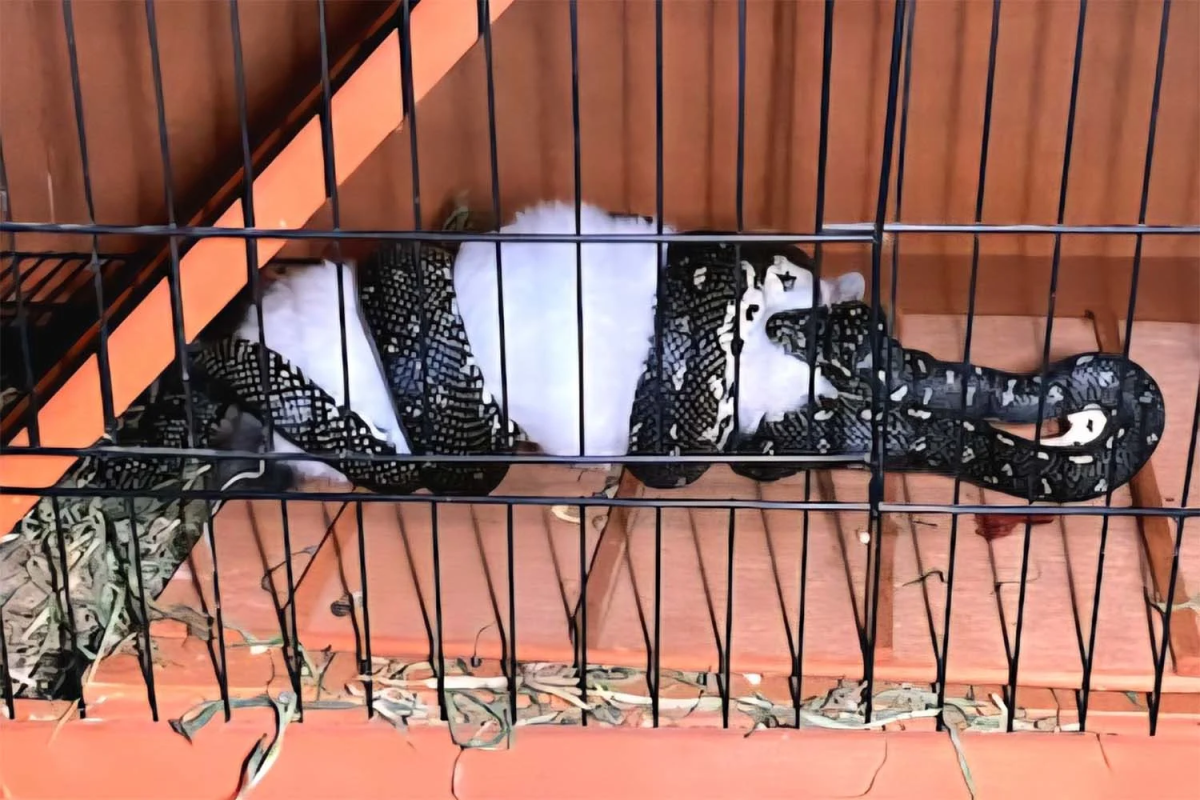
A simple weekend surprise for the grandchildren turned into heartbreak for one Sydney family.
Their excitement over a new rabbit quickly gave way to shock and disbelief.
Nature had unexpectedly knocked on their backyard door.
The family of Eagle Vale had placed their rabbit safely in its hutch, expecting it to enjoy a peaceful first weekend at its new home.
Instead, they discovered the animal caught in the grip of a diamond python.
Cory Kerewaro from Reptile Relocation Sydney arrived to find a 1.8-metre python coiled around the rabbit.
'The family were pretty freaked out. They were a bit distraught seeing that.'
The snake had slipped between the cage bars and settled in for what it hoped would be a meal.
The rabbit proved too large to swallow, and after some time the python gave up, allowing Cory to relocate it to a more suitable habitat.
'They're all coming out of their winter shelter sites, and they're all feeding and on the move.'
Diamond Pythons are among Australia’s most placid snakes, rarely hissing or threatening people.
They are completely non-venomous and pose no risk to humans.
Adults can grow up to three metres long, though they are generally around two metres, making their size intimidating but their temperament calm.
These reptiles are the most southerly occurring pythons in the world and inhabit higher altitudes than any other Australian python.
While they are not considered endangered, habitat destruction has reduced their presence in Sydney, increasing the chance of backyard encounters.
Diamond python quick facts
Completely non-venomous and generally docile
Can live up to 20 years
Males have territories of around 45 hectares
Become most active in November during breeding season
Primarily nocturnal but may bask during the day
Diamond Pythons become most active as September approaches, ramping up movement in November for breeding.
Male pythons may travel up to 500 metres a day following the scent of a receptive female.
This roaming behaviour increases the likelihood of encounters with suburban pets.
They are drawn to backyards containing aviaries, rabbits, guinea pigs and chickens, seeing these animals as potential food.
Mostly nocturnal, they also bask in early morning or late afternoon sun and on warm overcast days, meaning pet owners must be vigilant at dawn and dusk.
Cory recommended a simple, affordable barrier: mouse mesh, or snake mesh, which costs around $15 per metre at Bunnings, plus a packet of cable ties for a complete protection system.
'It's like chicken wire but with much smaller squares, so nothing can get in there. It's as simple as that—just that little bit extra of a barrier makes it completely safe.'
Enclosures should have no holes larger than a 20-cent coin—roughly 2.8 centimetres—to stop snakes from entering.
Complete pet protection checklist
Install mouse/snake mesh with gaps no larger than a 20-cent coin
Secure all entry points including underneath hutches
Check fencing regularly for gaps or damage
Remove food sources that attract prey animals
Keep grass and vegetation trimmed around pet areas
Install motion-sensor lighting for early detection
Mesh is just the first step—owners must think like a predator.
Snakes can access pets from above, sometimes entering roof spaces or outbuildings.
Raising hutches by at least 30 centimetres, adding solid roofs or fine mesh coverings, and installing motion-sensor lights can further protect pets.
Cory urged caution when pets are threatened.
The 2018 case of a Tamworth man fatally bitten by a brown snake while trying to rescue his dog highlights the dangers.
'I know it absolutely sucks if the pets get involved. Try to get the pet away if it is safe to do so, but sometimes you just can't, so call a catcher like myself and we'll get it sorted.'
Professional snake removal typically costs $150–300, depending on location and difficulty, with many services operating 24/7 during peak season.
Diamond Pythons can live up to 20 years, meaning repeated sightings in the same area may involve the same snake.
Homeowners can build long-term coexistence strategies rather than reacting to single encounters.
Female pythons may use roof cavities to wait for mates, but their presence can reduce rodent numbers.
Pet areas should remain secure, while other zones can serve as wildlife corridors to allow safe passage for native animals.
This incident reflects a broader trend as urban expansion encroaches on wildlife habitats.
Proper pet protection reduces negative encounters and limits the need for drastic wildlife management.
Diamond Pythons are threatened by land clearing, road fatalities, illegal collection, and habitat removal.
Killing native snakes is illegal in Australia, with fines ranging from hundreds to thousands of dollars depending on the state.
Prevention and professional management remain the safest approach.
Sharing experiences helps other families protect their pets.
If you have had wildlife encounters or implemented successful protection measures, your knowledge could prevent heartbreak for someone else.
What This Means For You
Diamond Pythons are non-venomous and generally docile, but they are increasingly coming into contact with suburban pets due to habitat loss.
Simple barriers like mouse mesh and cable ties provide an effective and affordable way to protect your pets from unexpected snake encounters.
Keeping pets safe also means thinking like a predator—securing enclosures not only at ground level but also from above to prevent snakes from finding alternative access points.
When a snake does threaten your pets, professional removal is the safest option, and ongoing education about wildlife behaviour helps prevent future incidents.
For pet owners, especially those in suburban areas, these measures are crucial in safeguarding beloved animals while living alongside Australia’s native wildlife, ensuring peace of mind and long-term safety for both pets and homeowners.
Diamond Python—The Australian Museum — Overview of Diamond Python habitat, noting they are found in large bushland areas and national parks around Sydney, often going undetected due to nocturnal habits.
[URL='https://australian.museum/lea...m/learn/animals/reptiles/diamond-python/[/URL]
Diamond Python—Backyard Buddies — Explains that Diamond Pythons are non-venomous and among the most placid snakes in Australia, rarely threatening people.
[URL='https://backyardbuddies.org.a....org.au/backyard-buddies/diamond-python/[/URL]
Diamond Python Australia: ID, Dangers & Safety Tips — Confirms Diamond Pythons are non-venomous, pose no threat to humans, and are generally calm and docile.
[URL='https://sydneysnakes.com.au/u...e/non-venomous/diamond-python-australia/[/URL]
Diamond Python—Backyard Buddies — Notes that Diamond Pythons can grow up to three metres but are generally around two metres in length.
[URL='https://backyardbuddies.org.a....org.au/backyard-buddies/diamond-python/[/URL]
Morelia spilota spilota—Wikipedia — Details that the Diamond Python is the most southerly occurring python in the world and found at higher altitudes than any other Australian python species.
[URL='https://en.wikipedia.org/wiki...kipedia.org/wiki/Morelia_spilota_spilota[/URL]
Diamond Python—The Australian Museum — Explains that the species is less widespread in Sydney than before and is under pressure from habitat destruction, though not considered endangered.
[URL='https://australian.museum/lea...m/learn/animals/reptiles/diamond-python/[/URL]
Diamond Python—Backyard Buddies — States that Diamond Pythons become most active in November for mating and egg-laying.
[URL='https://backyardbuddies.org.a....org.au/backyard-buddies/diamond-python/[/URL]
Diamond Python—Backyard Buddies — Notes that males travel up to 500 metres daily following the scent of a female ready to mate.
[URL='https://backyardbuddies.org.a....org.au/backyard-buddies/diamond-python/[/URL]
Diamond Python—Backyard Buddies — Explains that Diamond Pythons often visit backyards with aviaries, chickens, rabbits, or guinea pigs, viewing them as potential food.
[URL='https://backyardbuddies.org.a....org.au/backyard-buddies/diamond-python/[/URL]
Mostly Nocturnal, Inoffensive, Non-venomous… Diamond Pythons—The Beast — Describes their activity patterns, being mostly nocturnal but also active in early morning and late afternoon, and on warm overcast days.
[URL='https://thebeast.com.au/other...noffensive-non-venomous-diamond-pythons/[/URL]
Diamond Python—Backyard Buddies — Advises pet enclosures have no holes larger than a 20-cent coin to prevent snake entry.
[URL='https://backyardbuddies.org.a....org.au/backyard-buddies/diamond-python/[/URL]
Mostly Nocturnal, Inoffensive, Non-venomous… Diamond Pythons—The Beast — Notes that in urban areas, Diamond Pythons may occupy outbuildings and suburban roof spaces.
[URL='https://thebeast.com.au/other...noffensive-non-venomous-diamond-pythons/[/URL]
Diamond Python—Backyard Buddies — Highlights that Diamond Pythons can live up to 20 years, so repeat sightings may involve the same individual.
[URL='https://backyardbuddies.org.a....org.au/backyard-buddies/diamond-python/[/URL]
Diamond Python—Backyard Buddies — States that roof cavities can be used by females waiting for mates, and there is no need to remove these snakes.
[URL='https://backyardbuddies.org.a....org.au/backyard-buddies/diamond-python/[/URL]
Mostly Nocturnal, Inoffensive, Non-venomous… Diamond Pythons—The Beast — Explains that Diamond Pythons face threats from habitat destruction, road fatalities, illegal collection, and removal of old habitat trees.
[URL='https://thebeast.com.au/other...noffensive-non-venomous-diamond-pythons/[/URL]
Incidents like the one in Eagle Vale are more common than many realise, and seeing how snakes can enter unexpected areas can be a real eye-opener.
One family learned just how unpredictable these visitors can be when a diamond python appeared inside their home, reminding us to stay vigilant around pets and property.
For another real-life example of a surprising encounter with a python, take a look at the story below.
Read more: Surprise guest slithers into Aussie home's kitchen
What wildlife have you encountered in your backyard, and how have you adapted your pet care routines to keep everyone safe?







